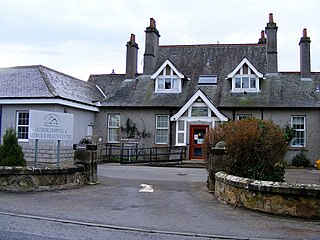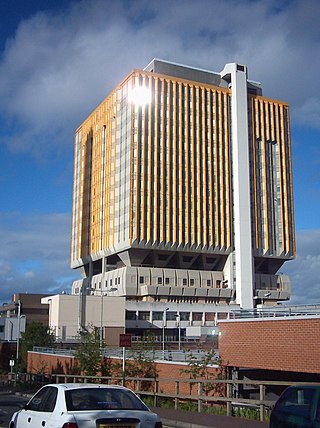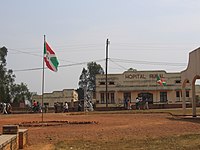
Cranleigh is a village and civil parish, about 8 miles (13 km) southeast of Guildford in Surrey, England. It lies on a minor road east of the A281, which links Guildford with Horsham. It is in the north-west corner of the Weald, a large remnant forest, the main local remnant being Winterfold Forest directly north-west on the northern Greensand Ridge.

The Royal London Hospital is a large teaching hospital in Whitechapel in the London Borough of Tower Hamlets. It is part of Barts Health NHS Trust. It provides district general hospital services for the City of London and Tower Hamlets and specialist tertiary care services for patients from across London and elsewhere. The current hospital building has 845 beds and 34 wards. It opened in February 2012.

A children's hospital(CH) is a hospital that offers its services exclusively to infants, children, adolescents, and young adults from birth up to until age 18, and through age 21 and older in the United States. In certain special cases, they may also treat adults. The number of children's hospitals proliferated in the 20th century, as pediatric medical and surgical specialties separated from internal medicine and adult surgical specialties.

Castle Peak Hospital is the oldest and largest psychiatric hospital in Hong Kong. Located east of Castle Peak in Tuen Mun, the hospital was established in 1961. It has 1,156 beds, providing a wide variety of psychiatric services such as adult psychiatry, forensic psychiatry, psychogeriatric services, child and adolescent psychiatry, consultation-liaison psychiatry and substance abuse treatments. All wards in the hospital are equipped to accommodate both voluntary and involuntary admitted patients.
A public hospital, or government hospital, is a hospital which is government owned and is fully funded by the government and operates solely off the money that is collected from taxpayers to fund healthcare initiatives. In almost all the developed countries but the United States of America, and in most of the developing countries, this type of hospital provides medical care free of charge to patients, covering expenses and wages by government reimbursement.

The Royal Infirmary of Edinburgh (RIE), often known as the Edinburgh Royal Infirmary (ERI), was established in 1729 and is the oldest voluntary hospital in Scotland. The new buildings of 1879 were claimed to be the largest voluntary hospital in the United Kingdom, and later on, the Empire. The hospital moved to a new 900 bed site in 2003 in Little France. It is the site of clinical medicine teaching as well as a teaching hospital for the University of Edinburgh Medical School. In 1960, the first successful kidney transplant performed in the UK was at this hospital. In 1964, the world's first coronary care unit was established at the hospital. It is the only site for liver, pancreas and pancreatic islet cell transplantation and one of two sites for kidney transplantation in Scotland. In 2012, the Emergency Department had 113,000 patient attendances, the highest number in Scotland. It is managed by NHS Lothian.

Fleming Hospital is a UK National Health Service hospital in Aberlour, Morayshire, Scotland. It is administered by NHS Grampian.

Beaumont Hospital is a large teaching hospital located in Beaumont, Dublin, Ireland. It is managed by RCSI Hospitals - one of the hospital groups established by the Health Service Executive. Its academic partner is the Royal College of Surgeons in Ireland.

The Belfast City Hospital in Belfast, Northern Ireland, is a 900-bed modern university teaching hospital providing local acute services and key regional specialities. Its distinctive orange tower block dominates the Belfast skyline being the third tallest habitable storeyed building in Northern Ireland. It has a focus on the development of regional cancer and renal services. It is managed by Belfast Health and Social Care Trust and is the largest general hospital in the United Kingdom. In April 2020, due to the global coronavirus pandemic, the tower block was designated one of the UK's Nightingale Hospitals.

Sharp HealthCare is a not-for-profit regional health care group located in San Diego. Sharp includes four acute care hospitals, three specialty hospitals, three affiliated medical groups, and a health plan. Sharp has approximately 2,600 physicians, and more than 18,000 employees.

Dumfries and Galloway Royal Infirmary is the main hospital in Dumfries and Galloway, Scotland. The hospital is managed by NHS Dumfries and Galloway.

Westminster Hospital was a hospital in London, England, founded in 1719. In 1834 a medical school attached to the hospital was formally founded. In 1939 a newly built hospital and medical school opened in Horseferry Road, Westminster. In 1994 the hospital closed, and its resources were moved to the new Chelsea and Westminster Hospital at the old St Stephen's Hospital site in Fulham Road.

NHS Dumfries and Galloway is an NHS board serving the Dumfries and Galloway region. It is one of the fourteen regions of NHS Scotland. NHS Dumfries and Galloway provides health care and promotes healthy living for the people of Dumfries and Galloway.

A hospital is a healthcare institution providing patient treatment with specialized health science and auxiliary healthcare staff and medical equipment. The best-known type of hospital is the general hospital, which typically has an emergency department to treat urgent health problems ranging from fire and accident victims to a sudden illness. A district hospital typically is the major health care facility in its region, with many beds for intensive care and additional beds for patients who need long-term care.

The state of medical knowledge at the time of the Civil War was extremely primitive. Doctors did not understand infection, and did little to prevent it. It was a time before antiseptics, and a time when there was no attempt to maintain sterility during surgery. No antibiotics were available, and minor wounds could easily become infected, and hence fatal. While the typical soldier was at risk of being hit by rifle or artillery fire, he faced an even greater risk of dying from disease.
Rufayda Al-Aslamia, was an Arab medical and social worker recognized as the first female Muslim nurse and the first female surgeon in Islam. She is known as the first nurse in the world.
The history of hospitals began in antiquity with hospitals in Greece, the Roman Empire and on the Indian subcontinent as well, starting with precursors in the Asclepian temples in ancient Greece and then the military hospitals in ancient Rome. The Greek temples were dedicated to the sick and infirm but did not look anything like modern hospitals. The Romans did not have dedicated, public hospitals. Public hospitals, per se, did not exist until the Christian period. Towards the end of the 4th century, the "second medical revolution" took place with the founding of the first Christian hospital in the eastern Byzantine Empire by Basil of Caesarea, and within a few decades, such hospitals had become ubiquitous in Byzantine society. The hospital would undergo development and progress throughout Byzantine, medieval European and Islamic societies from the 5th to the 15th century. European exploration brought hospitals to colonies in North America, Africa, and Asia. St Bartholomew's hospital in West Smithfield in London, founded in 1123, is widely considered the oldest functioning hospital today. Originally a charitable institution, currently an NHS hospital it continues to provide free care to Londoners, as it has for 900 years. In contrast, the Mihintale Hospital in Sri Lanka, established in the 9th century is probably the site with the oldest archaeological evidence available for a hospital in the world. Serving monks and the local community, it represents early advancements in healthcare practices.

The Metropolitan Free Hospital was a London hospital, founded in 1836 and based for most of its existence in Kingsland Road, Hackney. It became part of the NHS in 1948, and closed in 1977, with its residual functions transferring to Barts Hospital.

The Aldeburgh Cottage Hospital is located at Park Road, Aldeburgh, Suffolk in England. Its 20 beds are currently run by Suffolk Community Healthcare, which in turn is run by Serco, an outsourcing company. The services of the hospital as a whole are delivered "on behalf of the NHS by Serco, East Suffolk and North Essex NHS Foundation Trust and Community Dental Services CIC."
The Overseas Plastic Surgery Appeal is a registered charity in the UK, that exists to provide free facial surgery for poor children and young adults in Pakistan. The OPSA team operate on facial abnormalities including cleft lip and palate.






















